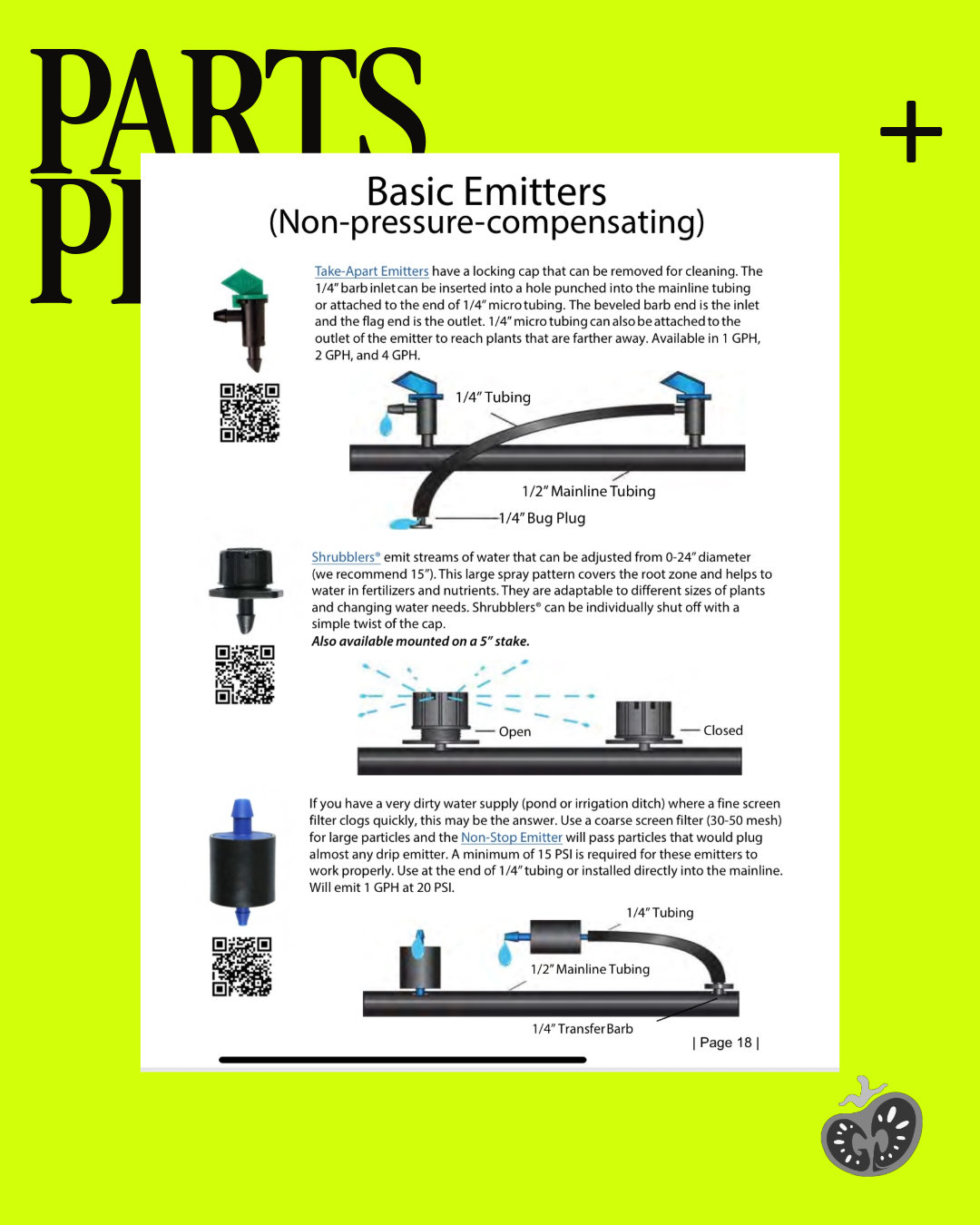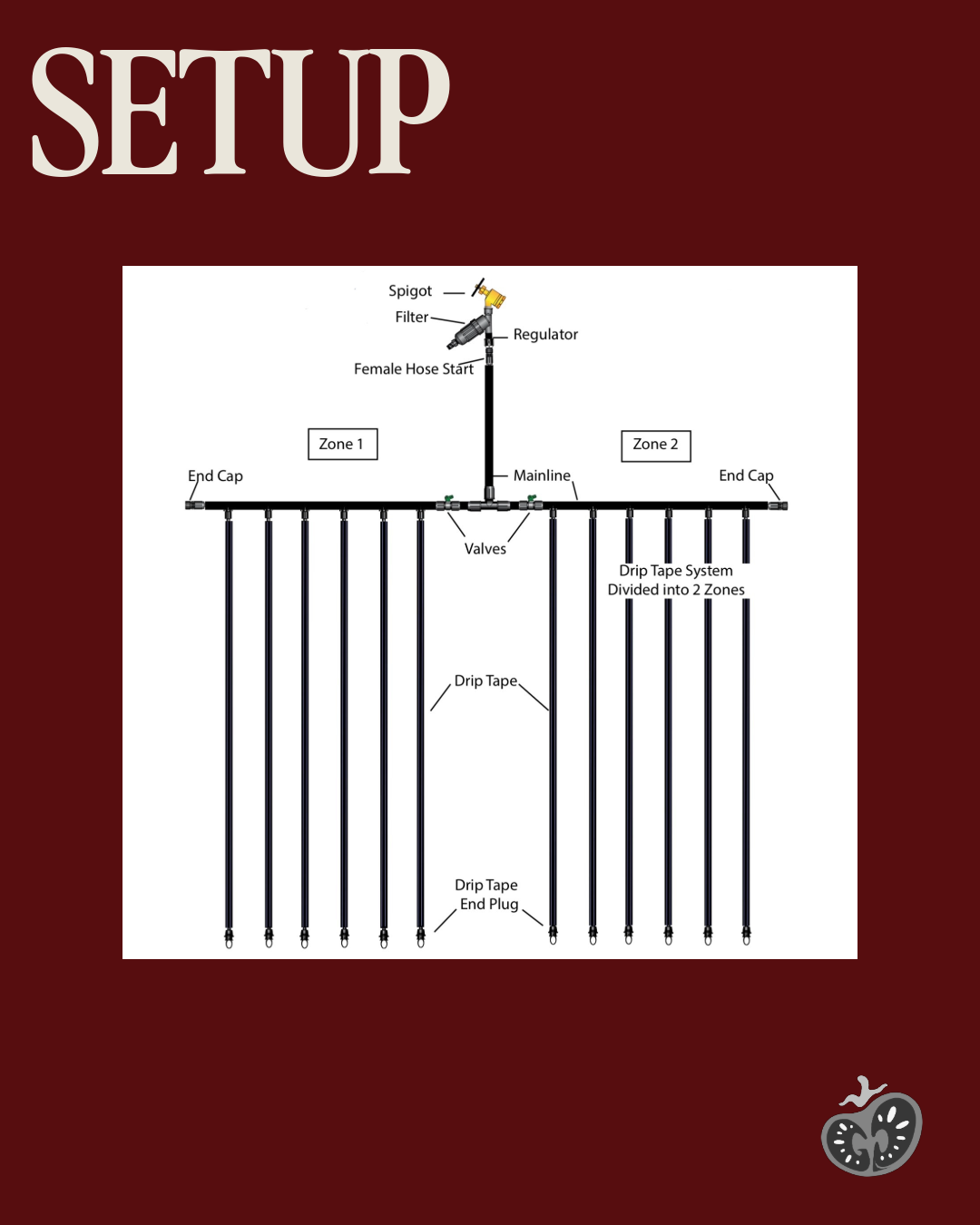Irrigation
Vegetables are 80 to 95 percent water, so their yield and quality is very quickly affected by a lack of water. Most vegetables and flowers need 1 to 1½ inches of water per week.
Poor watering practices lead to many common landscape problems, including iron chlorosis, low plant vigor, foliar diseases, root rots, and water pollution.
The most efficient and popular way to deliver water to crops is by drip irrigation. Compared to sprinkler irrigation, drip uses 20 to 40 percent less water and can be used on windy days and on any type of topography. Besides saving water by delivering it directly to the plants' root zone, drip also helps prevent foliar disease in crops and reduces weed growth outside the crop row.
Plants vary in their ability to extract water from the soil. For most plants, the available water is about 50% of the soil's total water supply before reaching the permanent wilting point.
Tools to Evaluate
Soil Moisture
Plant observation
The hand feel method
Soil moisture meters
Plants have evolved with a variety of drought mechanisms: • Small leaves, waxy leaves, hairy leaves, and light-colored leaves are characteristics of many plants with lower water requirements. • Some plants, like cacti, have internal water storage supplies and waxy coatings. • Many plants, like impatiens, readily wilt as an internal water conservation measure.
SIGNS OF WATER STRESS
a) Graying leaves: A change in leaf color from a vibrant green to a dull gray-green or bluish color
b) Loss of sheen: Plant leaves change from glossy to dull in appearance
c) Insect damage: The presence of cabbage aphids on Brassica family crops (broccoli, cabbage, kohlrabi, etc.) often indicates dry conditions
d) Damage to the root system: Upon closer examination, plants that look dry even after watering often have root damage, e.g., from symphylans, and can't take up sufficient water
e) Red or purple leaf color: Can indicate dry conditions, saturated conditions (anaerobic), or root damage
f) Development of small spines on the leaf margins or increased spinyness on stems: This condition is especially likely to occur in lettuce and related species such as endive that experience water stress
g) Wilting: Pay attention to the time of the day. If plants wilt early in the cool of the day, this can be a sign that they need water. Some wilting in the mid-day heat (e.g., zucchini, winter squash) is a plant-protective strategy to reduce transpiration losses.
h) Slower than expected growth: This can be detected over time with a practiced eye
WHY NOT TO OVER-IRRIGATE • Over application of water may result in nutrient leaching, especially Nitrogen (N). Statewide, the nitrate pollution of groundwater is a serious concern. Nitrogen leaching can be a significant issue even on organic farms if water and/or N are over applied. • Excess water often germinates additional weed seeds that would have otherwise remained dormant in the soil. Higher weed pressure leads to higher labor costs for weed removal, and creates more crop competition resulting in decreased yields. • Additional soil compaction will result from tractor cultivation or foot traffic following excess irrigation. • Fresh water is a precious and limited resource!
DECIDING HOW MUCH TO IRRIGATE
WHY NOT TO UNDER-IRRIGATE • It's important to maintain moisture levels in the soil; most crops need consistent watering for uniform fruit production (with some exceptions) • Lack of proper irrigation stresses plants which results in lower and/or inconsistent yields, stress also correlates with increased pest pressure
EVAPOTRANSPIRATION
Evaporation: is the transformation of water from a liquid to a gas. Evaporation happens only at the surface of a liquid, therefore, the greater the ratio of surface area- to - volume, the greater the evaporation rate. This means, more water is lost to evaporation when sprayed through the air in drops, than when applied via irrigation canal, ditch, or drip tape. The evaporation rate (the time it takes for a certain amount of water to volatilize) can be influenced by environmental factors like heat and wind. Transpiration: is the transformation and use of water by a plant. Plants use water to transport nutrients and air, maintain their structure, and thermoregulate (maintain optimal temperature). The transpiration rate refers to the amount of water a plant uses over a given amount of time. Evapotranspiration / ET: is the combined use of water by plants and loss of water into the air. The evapotranspiration rate is the amount of water that needs to be replaced over a given amount of time, to compensate for water that has been used or volatilized. Plants need both light and Carbon Dioxide for photosynthesis; it is when plants open up their stomata (the microscopic pores on the underside of leaves) to take in CO2 from the atmosphere, that they lose water
DRIP TAPE PROCEDURES TURNING ON THE FIELD DRIP-TAPE SYSTEM
• Pull the lines straight, from the back of the field. The plastic softens and stretches in the sun, pulling the lines taught ensures more even distribution.
• Slowly open the ball-valved riser, until ¼ to ½ open. Open slowly to prevent hammer lock (a sudden change in pressure that causes the pipes to shudder, and can result in a blow out). Listen for the pressure reducer to engage. Turn down if pressure reducer squeeling.
• Note the start time, so that you know when turn off the water.
• Walk the lines, to make sure all open lines have pressurized. Listen and look for leaks and inconsistencies.
• Check for leaks and tighten as necessary along poly-tube header
• Repair leaks as needed, with couplers and make any relevant notes about the quality of the line in the field notes.
SOURCES:
1. Clark, G.A. et al. 1990. Irrigation scheduling and management of micro-irrigated tomatoes. 2. Cook, W.P. and D.C. Sanders. 1991. Nitrogen application frequency for drip-irrigated tomatoes. HortScience 26:250-252. 3. Crespo-Ruiz, M. et al. 1988. Nutrient uptake and growth characteristics of peppers under drip irrigation and plastic mulch. J. Agric. Univ. P. Rico. 72:575-584. 4. Fereres, E. (ed.) 1992. Drip irrigation management. Univ. Calif. Coop. Ext. Serv. Lf. 21259. 5. Hochmuth, G. 1991. Fertilizer management for drip irrigated Vegetables in Florida. pp. 12-38. In: Proc. Drip Irri. Veg. Crops Short Course, 25 July, 1991. Penn. State Univ.









